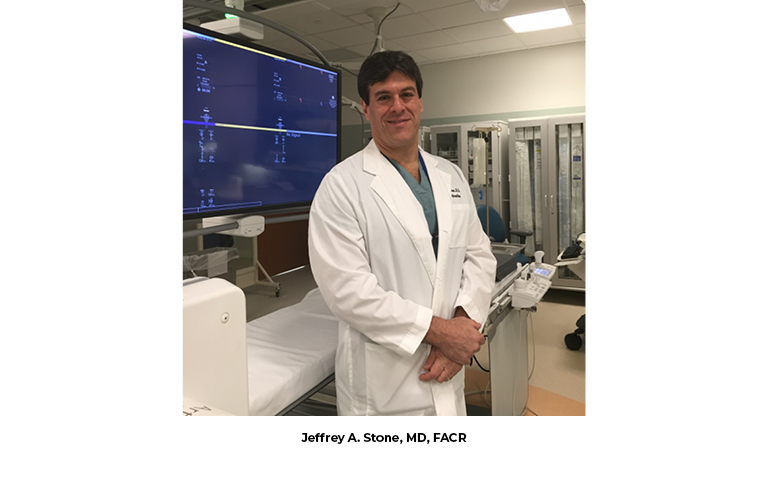Jeffrey A. Stone, MD, FACR, is a big advocate of involvement at the state chapter level. In fact, he attributes his success in radiology to it. “When I moved to Florida in 2007, one of my colleagues there who’s very active in the Florida Radiological Society (FRS) encouraged me to get involved early on — so I hit the ground running in the FRS,” says Stone. “I love doing state chapter work because I really enjoy the mechanism of building better societies; it’s just been so rewarding.”
Stone was recently named the recipient of the Gold Medal Award from the FRS, the organization’s highest honor. Stone, an associate professor of diagnostic and interventional neuroradiology specializing in spinal disorders/intervention and pain management at Mayo Clinic Florida, served as president of the FRS from 2015–2016 and currently serves on six FRS committees. Additionally, he has participated in numerous capacities for the American Society of Neuroradiology (ASNR), the North American Spine Society (NASS), the ACR, and the American Society of Spine Radiology (ASSR). The Bulletin caught up with Stone to discuss his state chapter efforts, his work with the ACR, and his commitment to mentoring the next generation of radiologists.
How did you get involved in your chapter?
I was first involved with the ACR a lot through the ASSR, where I started out as a society representative to the ACR’s Council. When I moved to Florida, I was still a representative for ASSR but became involved in the FRS through a colleague and quickly assumed state-related duties, including as councilor for the FRS after my ASSR term finished in 2010. I then ascended leadership, eventually holding the positions of secretary, treasurer, vice president, and president.
Tell us more about your work with the ACR.
I have been on the ACR Economics Committee on Coding and Nomenclature since 2006, primarily addressing coding questions from our membership regarding IR/interventional neuroradiology, as well as diagnostic neuroradiology. My work and ongoing learning in this committee led me to educate and speak on coding to professional coders through the American Academy of Professional Coders and subsequently to become a member of the Coding Committee for the NASS in 2014. My work with the Economics Committee also led to a brief stint as an alternative representative to the AMA/Specialty Society RVS Update Committee for the ASNR from 2008 to 2010.
The Task Force for Clinical Practice of IR and Interventional Neuroradiology was formed in 2012 to evaluate barriers and solutions to clinical practice within the areas of IR. My practice was unique as I was one of only a rare few with an active practice within the department of pain medicine, so I was appointed as chair of the section on spine, MSK, and pain medicine. The efforts of this Task Force led to publications on ways that members could enhance their clinical practices as well as the identification of a wide range of practice models (learn more in this case study®Imaging 3.0).
Why did you decide to work with residents?
I joined the board of the FRS Educational Foundation in 2013. One core mission of the Foundation is to promote and advance the medical practice and science of radiology and radiation oncology through scholarships and grants to individuals in practice or training. Through the Foundation, we raise money to send our residents to the ACR’s annual meeting as well as to a legislative session here in Tallahassee. We also support any resident or fellow in the state of Florida who submits a poster or wants to come to the FRS state chapter meeting.
In 2017, I became the president of the Foundation, and I started a special scholarship to honor the memory and legacy of Martin Northup, MD, FACR, a long-term member and past president of the FRS and tremendous advocate for resident education and participation. The scholarship is given to one resident per year and is meant to foster promising leadership abilities for future involvement in the ACR and the FRS. As part of the scholarship, the resident essentially “shadows” the past FRS president — and this way they have a mentor to teach them about everything that goes on within the FRS and how it pertains to the ACR.
What has your work in PFCC meant to you?
Of all the work I’ve done, it’s the patient care that has meant the most to me — whether it’s curing cerebrovascular disease, working with patients after a stroke, or hearing from patients experiencing pain relief. We get a lot of complicated patients, and my work with patients experiencing severe pain is very meaningful. These patients are often physically limited or disabled, with associated emotional and psychological dysfunction secondary to their suffering — and then following a very short procedure, they’re doing their normal activities and feeling so thankful. I think most of us go into medicine to help patients — and when a patient thanks you and says, “I really appreciate your care,” that means more than anything.

